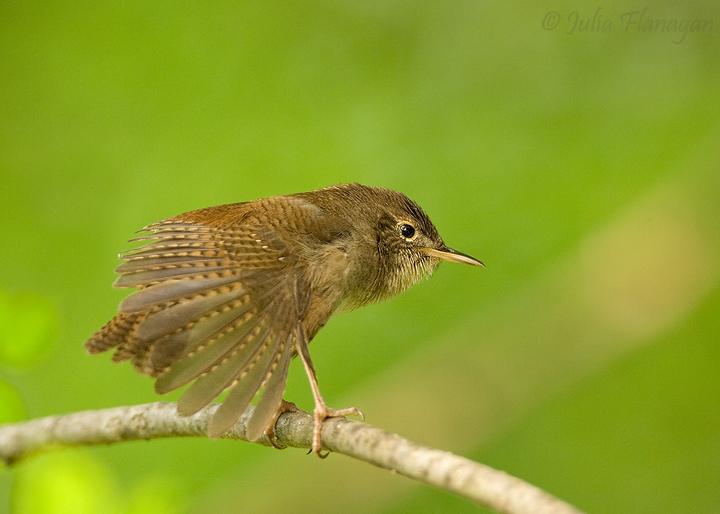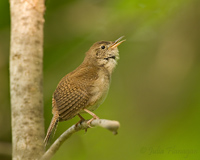
 |
Photos
© Julia Flanagan; Magee Marsh, Ohio; May 2009 |
House Wren The House Wren's scientific name calls it a "troglodyte", which means "one who lives in caves". Why is this little brown bird like a caveman? In their range throughout all but the coldest parts of the Western Hemisphere, these birds build nests in natural cavities, such as woodpecker holes, and also in artificial ones in houses and barns, including mailboxes, cans and jars, and even abandoned boots and shoes. Both birds build the nest, made of sticks and lined with softer materials. The male bird feeds the female while she is sitting on the eggs and later he helps to feed the young. They are fierce competitors with Eastern Bluebirds for nesting boxes, so that special care must be taken to avoid providing homes for them instead of for that more colorful and threatened species. House Wren pairs also aggressively defend their territory against other species, often damaging their nests and eggs. So the wrens exhibit some "uncivilized behavior" to accompany their "cave-dwelling" habit. Somewhat smaller than a sparrow, the House Wren is dull brown above and pale grayish-brown below, with dark barring on the wings and back and only a faint pale line over the eye. Its short tail, unlike that of a sparrow, is held angled up when the bird is perching or walking. Its short down-curved bill is used for plucking insects and spiders from the ground or trees. This wren can be found in open forests, along forest edges, and in areas with scattered grass and trees, such as farmyards, suburban back yards, and city parks. In winter the birds become more secretive, preferring brushy tangles, thickets, and hedges and heavy undergrowth. Birds living in the most northern parts of the species' range, including Virginia, migrate to the southern US and Mexico. So if you see a wren in Northern Virginia in wintertime, it will most likely be the "better-dressed" Carolina Wren, with a long elegant white stripe over its eye. |
Home | Upcoming Events | About Us | Resource Issues | News | Local Contacts Maps | Photos | Publications | Youth Education | FAQ's | Links | Membership |





